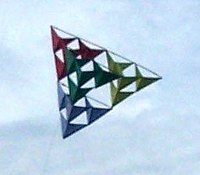Tetrahedral kite

Atetrahedral kiteis a multicelled rigidbox kitecomposed oftetrahedrallyshaped cells to create a kind oftetrahedral truss.The cells are usually arranged in such a way that the entire kite is also a regulartetrahedron.The kite can be described as a compounddihedral kiteas well.

This kite was invented byAlexander Graham Bell.It came about from his experiments withHargrave's box kitesand his attempts to build a kite that was scalable and big enough to carry both a man and a motor. As such, it was an early experiment on the road to manned flight. He worked on the kites between 1895 and 1910.[1]Bell wrote about his discovery of this concept in the June 1903 issue ofNational Geographicmagazine; the article was titled "Tetrahedral Principle in Kite Structure".[2]
From an initial one-cell model, Bell advanced to a 3,393-cell "Cygnet "modelin 1907. This 40-foot-long (12.2 m), 200-pound (91 kilogram) kite was towed by a steamer offshore nearBaddeck, Nova Scotia,on December 6, 1907, and carried a man 168 feet (51.2 metres) above the water.
Bell also experimented with a large circular "tetrahedral truss" design during the same period.[3]
The tetrahedral kite is stable and easy to fly, but is not a light-wind kite. The large number of structural spars makes it relatively heavy and it requires moderate to strong winds.
See also
[edit]References
[edit]- ^"History of Aviation",GlobalAircraft.org 2008
- ^Alexander Graham Bell (June 1903)"Tetrahedral principle in kite structure,"National Geographic Magazine,14(6): 219–251. Also available on-line at:Catch-the-wind.de.
- ^"In Pictures: Tetrahedral Kites by Alexander Graham Bell · Lomography".Archived fromthe originalon 2018-05-03.

